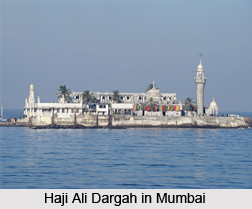 The religious monuments of Mumbai are evidence of the multiplicity of cultures that have inhabited and continue to live in the great city. A number of churches, mosques and temples can be found dotting the landscape Also of note here are a number of religious monuments of Zoroastrianism, as a great many people of the Parsi community have inhabited the city from generations.
The religious monuments of Mumbai are evidence of the multiplicity of cultures that have inhabited and continue to live in the great city. A number of churches, mosques and temples can be found dotting the landscape Also of note here are a number of religious monuments of Zoroastrianism, as a great many people of the Parsi community have inhabited the city from generations.
One of the prime religious monuments of Mumbai is the Haji Ali Dargah. The Dargah was built in 1431 by Haji Ali, a rich Muslim merchant who gave up all worldly pleasures before going on a pilgrimage to Mecca. It is situated 500 yards from the shoreline in the centre of Worli Bay. This dargah was built in the ocean and joined to the mainland by means of a narrow pathway. This pathway is more than 1312 feet in length and can be walked on only during a period of low tide. Constructed as a fine example of the Indo-Islamic style of architecture, the dargah features a single minaret and a beautiful marble courtyard. The central shrine is placed in the courtyard. The tomb is always covered by a brocaded red and green sheet supported by a delicate silver frame. There are marble pillars within the hall which are adorned with mirrors with multiple hues.
There are a number of mosques by the name of Jama Masjid in India, and one such mosque is also found in Mumbai. The original Jama Masjid in Mumbai was located at Dongri and later moved to Esplanade. The mosque was demolished under the orders of Governor William Hornby in 1770. Again a re-construction o0f the mosque was started and the Jama Masjid see today was built in 1775.The work on it was finally completed in 1802, while the upper storey was added in 1837. A quadrangular pile of brick and stone comprises the mosque. It is surrounded by a ring of terraced double- storied buildings. There is and ancient tank here, reached from the Eastern gate, filled with about 10 feet of water. Sixteen black stone arches arise from the centre of the tank, and it is on these arches that the entire mosque is supported.
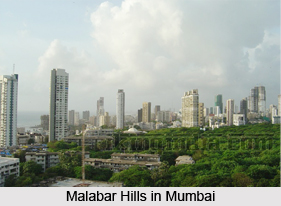 The Mahalakshmi temple is situated on the northern side of the Malabar Hills in Mumbai. The chief deity here is that of Goddess Lakshmi and hence the name Mahalakshmi. There are three deities enshrined in the temple- Mahalakshmi, Mahasaraswati and Mahakali. The temple was built in 1785.The images of all three deities are beautifully adorned with gold bangles, pearl necklaces and nose rings. The chief deity of Mahalakshmi can be seen riding a tiger and the demon Mahishasur in tandem. Of great importance here is the festival of Navaratri which is celebrated with great festivity in the temple.
The Mahalakshmi temple is situated on the northern side of the Malabar Hills in Mumbai. The chief deity here is that of Goddess Lakshmi and hence the name Mahalakshmi. There are three deities enshrined in the temple- Mahalakshmi, Mahasaraswati and Mahakali. The temple was built in 1785.The images of all three deities are beautifully adorned with gold bangles, pearl necklaces and nose rings. The chief deity of Mahalakshmi can be seen riding a tiger and the demon Mahishasur in tandem. Of great importance here is the festival of Navaratri which is celebrated with great festivity in the temple.
The Siddhivinayak temple is dedicated to Lord Ganesha. A number of people from all walks of life are seen lining up to pay homage at the temple. On some days, especially Tuesday which is an auspicious day the queue of worshippers is seen to be almost 24kms long.
The Walukehwar temple is among one of Mumbai`s ancient Hindu sites. Dedicated to Walukeshwar or Sand-Lord, the temple is situated towards the end of Malabar Hill. The original temple was built in 1050 AD by the Silahara dynasty of Konkan.It is said to contain a lingam brought by Lord Lakshman from Varanasi and a sand lingam crafted by Lord Rama. The Portuguese had destroyed the original temple and the one we see today was re-built in 1715.The Banganga tank found here is believed to be filled by a spring that was created from an arrow shot forth from the bow of Lord Rama himself.
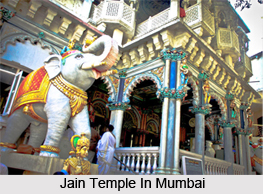 Near the steps leading to the towers is the distinctive profile of the Babulnath Temple. Located at an altitude of 100 feet above sea level, this temple is dedicated to Lord Shiva who is found here in the form of the Babul tree. The temple was built in 1780, and later a tall spire was added to it in 1900. It is a spacious and grand temple where devotees flock in hordes to offer their prayers.
Near the steps leading to the towers is the distinctive profile of the Babulnath Temple. Located at an altitude of 100 feet above sea level, this temple is dedicated to Lord Shiva who is found here in the form of the Babul tree. The temple was built in 1780, and later a tall spire was added to it in 1900. It is a spacious and grand temple where devotees flock in hordes to offer their prayers.
The Jain temple of Mumbai is located on Malabar Hill. It houses a black marble shrine and the ceiling is decorated with the celestial personifications of the various planets. There are a number of frescoes found here which depict the life of the twenty-four Trithankaras.
A number of churches are also to be found here dating back to the time of colonial rule in Mumbai. For instance, the Afghan Memorial Church of St John the Baptist was designed by the town engineer Henry Conybeare and completed by Captain Tremcheere. The bell chamber and modified steeple were designed by Lieutenant James Augustus Fuller. The Church is important as it was the first in India to be designed using the new principles of Gothic architecture. It is Early English in style with a tall tower and spire, 189 ft high, which form a landmark from a considerable distance at sea. The walls are made of rubble faced in buff-coloured basalt from Coorla, with Porbandar stone piers, arches and dressings. Internally, the narrow lancet windows have some of the finest stained glass made by William Wailes; in particular, the great west window, the central panel of which depicts the Crucifixion and Jesus Christ seated in majesty. At the west end of the north aisle is a triple window of stained glass to General David Barr. In the west end of the south aisle is a fine Holditch organ. The chancel is paved with English encaustic tiles and between the lancet windows are the memorial marbles to the fallen of the Sind Campaigns and First Afghan War, 1835-43, in white, red, yellow and blue stone. The ornamental illuminated screen is a later addition, designed by William Butter-field. Many of the fittings were made by the Bombay School of Art.
The new Roman Catholic Church of the Holy name and the official residence of the Roman Catholic archbishop of Mumbai are also to be found among the monuments of Mumbai, located right behind the majestic hotel.
The St. Andrew`s Kirk is a simple neo-classical church in the manner of James Gibbs. The steeple was demolished by lightning in 1826 and rebuilt a year later by John Caldecott, FRS, Astronomer of Trivandrum University. The Church was constructed in 1819.
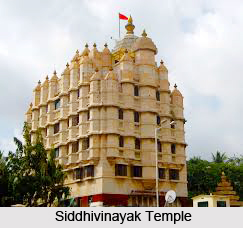 The construction of the St Thomas Cathedral was started in 1672 by Gerald Aungier and it opened in 1718. In 1833 the old belfry was replaced by the present tower. The interior is capacious, with a simple plan and plain Tuscan detail. The chancel (1865), by James Trubshawe, is a curious remnant of a much larger reconstruction scheme which failed with the financial collapse of 1865. The principal interest of the cathedral lies in its splendid heritage of monuments. The best is Bacon`s monument to Governor Jonathan Duncan, depicting him receiving the blessings of Hindus, commemorating his energetic suppression of infanticide in Varanasi and Kathiawar through his agent Colonel Walker. Duncan is buried under a pavement in the nave.
The construction of the St Thomas Cathedral was started in 1672 by Gerald Aungier and it opened in 1718. In 1833 the old belfry was replaced by the present tower. The interior is capacious, with a simple plan and plain Tuscan detail. The chancel (1865), by James Trubshawe, is a curious remnant of a much larger reconstruction scheme which failed with the financial collapse of 1865. The principal interest of the cathedral lies in its splendid heritage of monuments. The best is Bacon`s monument to Governor Jonathan Duncan, depicting him receiving the blessings of Hindus, commemorating his energetic suppression of infanticide in Varanasi and Kathiawar through his agent Colonel Walker. Duncan is buried under a pavement in the nave.
The monument to Katharine Kirkpatrick (1766), mother of Major-General William Kirkpatrick and Major James Achilles Kirkpatrick, who as Residents at Hyderabad established English supremacy in central India, is a fine marble medallion by Bacon. Note the eloquent inscription.
Other noteworthy monuments are Chantry`s figure of Stephen Babington, who revised the Judicial Code; and those to Captain Hardinge, RN, who seized the French cruiser Piedmontese in an audacious attack in 1808; to Colonel Burr, who commanded at the Battle of Kirkee on 5 November 1817 against the Peshwa; to Colonel John Campbell, heroic defender of Mangalore against Tipu Sultan in 1787; to Major Eldred Pottinger, the hero of Herat, by Bacon; to Admiral Maitland, who conveyed Napoleon to St Helena; and many others which mark the passage of the British in India.
In the chancel on the left-hand side is the tomb of General Carnac, Clive`s second-in-command at the Battle of Plassey. Nearby is a simple plaque to Henry Robertson Bowers, `noble Birdie Bowers`, who died with Scott of the Antarctic in 1912. A large chalice and cover (1675) presented by Governor Gerald Aungier are still preserved.
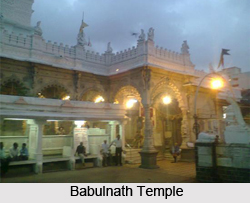 Outside the west door in the churchyard is a small Gothic fountain presented by Sir Cowasjee Jahangir Readymoney to the designs of George Gilbert Scott.
Outside the west door in the churchyard is a small Gothic fountain presented by Sir Cowasjee Jahangir Readymoney to the designs of George Gilbert Scott.
The Christ Church at Byculla was built in 1835.It has a Greek Doric portico using spare columns imported for use on the Town Hall. The stained-glass window (1870) commemorates Mr Spencer Compton. A fine monument to Sir Robert Grant and other tombs and brasses of interest can be seen.
The foundation of the All Saints` Church this church was laid by Lady Ferguson, the wife of Sir James Ferguson, the Governor of Mumbai. This Church became a permanent place of worship for the governors of Mumbai since 1881 as Malabar Hill turned to be their place of residence. The church has been designed in modern style by Major Mant of the Royal engineers. The walls have been constructed with what is possibly Porbander or Coorla stone and the roof is tiled with Mangalore tiles. It is a tall building 64 feet high, with a semi-circular chancel of about 16 feet in diameter and a ten feet square vestry. The Church was created as a separate ecclesiastical parish only in 1957.
Of note among the religious monuments of Mumbai are the places of worship of the Zoroastrian community which is settled here in great numbers.
The famous Five Parsee Towers of Silence, where the Parsees lay out their dead, are surrounded by gardens designed to foster contemplation and spiritual repose. The veneration of the elements of fire, water and earth dictate a unique form of disposal of the dead by their exposure to vultures and other birds of prey. The outer enclosure may be visited, but permission is required to proceed further. These towers of silence have virtually disappeared today, and only a handful continues to exist.
There is a Parsee Dharmsala which was built in 1812 in Gamdevi Road. It was built for poor Persian Parsees. The religious diversity of Mumbai, thus, is amply visible in the various religious monuments and places of worship that are scattered all over the city.



















